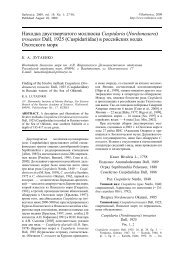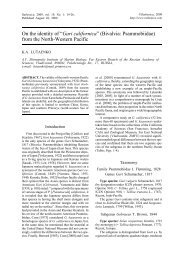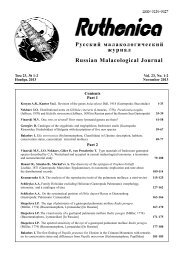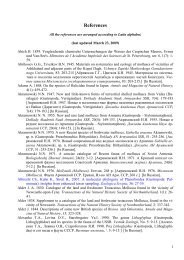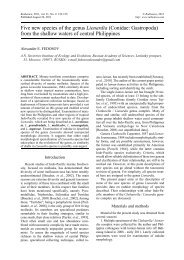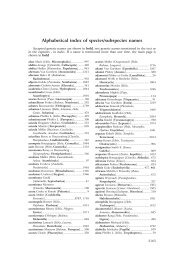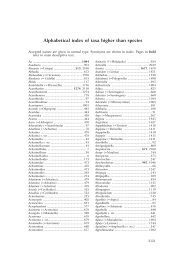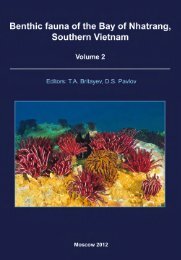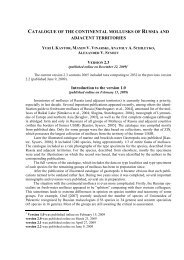Deshayesiella spicata - Ruthenica, Russian Malacological Journal
Deshayesiella spicata - Ruthenica, Russian Malacological Journal
Deshayesiella spicata - Ruthenica, Russian Malacological Journal
Create successful ePaper yourself
Turn your PDF publications into a flip-book with our unique Google optimized e-Paper software.
<strong>Ruthenica</strong>, 2008, vol. 18, No. 1: 1-7,Published November 5, 2008.©<strong>Ruthenica</strong>, 2008<strong>Deshayesiella</strong> <strong>spicata</strong> (Berry, 1919) (Mollusca: Polyplacophora),a valid speciesB. SIRENKO 1 , R. CLARK 21 Zoological Institute of the <strong>Russian</strong> Academy of Sciences, Universitetskaya nab.1, St.Petersburg, 199034, Russia, email: marine@zin.ru2 Research Associate, Dept. of Invertebrate Zoology, Santa Barbara Museum of NaturalHistory; 3808 E. Pinehurst Dr., Eagle Mountain, Utah, 84005 USA, email:insignis_one@yahoo.comABSTRACT. The validity of the enigmatic easternPacific chiton Deshaysiella <strong>spicata</strong> (Berry, 1919) isestablished, this species is redescribed, illustrated andcompared with related species in the western PacificOcean, as well as the similar appearing Oldroydiapercrassa (Dall, 1894) from Californian waters. Geographicand bathymetric ranges are characterized andthe living animal is illustrated.IntroductionThe nominal species Hanleya <strong>spicata</strong> was describedby S. Stillman Berry [1919] from a singlejuvenile specimen. The holotype (Fig. 1A-C) is verysmall (4.5 × 2.0 mm) and was preserved in balsam.The senior author noted “numerous rounded tuberclesirregularly scattered over the lateral areas butover the central areas slightly smaller and deposedin 14-16 ill-defined, slightly oblique, longitudinalseries most crowded and irregular near the jugum”,(and) “elongate, dagger-like, marginal spinelets anda few scattered needle-like spines, often over twicethe length of the marginal spicules, some of thesedistributed here and there over the general surfaceof the girdle, but the greater proportion occurring inloose groups of 5-8 at each suture, where they extendwell up between the valves” (Fig. 1C).Berry described the unique specimen as a newspecies but cautioned: “eventually H. <strong>spicata</strong> mayprove only a variant of the older species (Hanleyahanleyi)...” perhaps because of doubts, Dall [1921]and Oldroyd [1927] cited H. <strong>spicata</strong> Berry, as asubspecies of Hanleya hanleyi (Bean in Thorpe,1844). Cowan [1964] reported 40 specimens of Hanleyahanleyi from Queen Charlotte Sound, B. C.,but recent examination of these by the junior authorhas revealed them instead to be Hanleyella oldroydi(Dall, 1919). Ferreira [1979] concluded that nomembers of the genus Hanleya are present in Pacificwaters and placed <strong>spicata</strong> as a junior synonym ofOldroydia percrassa (Dall, 1894). Kaas and VanBelle [1985] agreed with Ferreira and retained <strong>spicata</strong>as a junior synonym of O. percrassa. In 1995,while working in the California museums, the seniorauthor found two different species among materialidentified as O. percrassa. The first of them matchedthe diagnosis of O. percrassa with a long jugal areacharacteristically projecting forward for almost halfthe length of the tegmentum. The remaining specimenswere alike in lacking long, distinct and projectingjugal area; instead their valves were verysimilar to other members of the genus <strong>Deshayesiella</strong>.We tried to study the holotype of Hanleya <strong>spicata</strong>at the Santa Barbara Museum of Natural History.Unfortunately it was not possible to see the anteriorportion of the jugal area because the whole specimenis imbedded in balsam and the valves overlap eachother.The tegmental sculpture and girdle armature ofour second species are otherwise very similar to theholotype of H. <strong>spicata</strong>. We found four specimensof <strong>Deshayesiella</strong> <strong>spicata</strong> in three California museumsand subsequently 6 additional specimens havebeen recovered (see Material examined). A redescriptionof <strong>Deshayesiella</strong> <strong>spicata</strong> follows.Acronyms used in the text are as follows: CASIZ,California Academy of Sciences, Invertebrate Zoology;LACM, Los Angeles County Museum of NaturalHistory; RBCM, Royal British Columbia Museum;SBMNH, Santa Barbara Museum of NaturalHistory; RNC, personal collection of Roger N.Clark.TaxonomyClass Polyplacophora Gray, 1821Subclass Loricata Shumacher, 1817Order Lepidopleurida Thiele, 1910Suborder Lepidopleurina Thiele, 1910
2 B.I. Sirenko, R. CLarkFIG. 1. Deshaysiella <strong>spicata</strong> (Berry, 1919). Holotype (after Berry, 1919). A — camera lucida drawing of the wholeanimal; B — photograph of the whole animal; C — close-up of girdle, camera lucida drawing.РИС. 1. Deshaysiella <strong>spicata</strong> (Berry, 1919). Голотип (по Berry, 1919). A — рисунок целого животного; B —фотография целого животного; C — увеличенный участок перинотума.Family Protochitonidae Ashby, 1925<strong>Deshayesiella</strong> Carpenter MS, Dall, 1879<strong>Deshayesiella</strong> <strong>spicata</strong> (Berry, 1919)Hanleya <strong>spicata</strong> Berry, 1919: 7-10 text, figs. 5,6, pl. 1,fig. 3; Smith, 1947a: 7, 1947b: 18; Smith & Gordon,1948: 205.Hanleya hanleyi <strong>spicata</strong>; Dall, 1921: 188; Oldroyd, 1927:253-254.Type material: Holotype in balsam, SBMNH4102 (S.S.B. 63). 4.5 mm in length.Type locality: California, Monterey Bay, offPoint Pinos, rock ledge, depth “probably 200 feet”.Additional material: 1, LACM 41-50 (ex AHF1220-410), Anacapa Id., California (34°00’05’’N,119°26’40”W), 25-26 fms. 13 mm in length; 1,LACM 39-88 (ex AHF 984-39), Santa Barbara, California(33°22’08”N, 119°02’39”W), 39-42 fms. 12mm in length; 1, CASIZ 2382, Mexico, Baja CaliforniaNorte, Gulf of California, Salsipuedes Channel,250 fms. 20 mm in length; 1, SBMNH 144483,S of Santa Rosa Id., ‘Santa Rosa Flats’ (33°51’03”N,119°56’00”W), 52 fms. 16 mm; 1, RBCM 002-00062-005, “Kelvin Grove”, S of Lions Bay, HoweSound (N of Vancouver), British Columbia(46°27.0’N, 123°14.4’W), 67 ft. 28 mm in length;1, RNC 1835, “Kelvin Grove”, S of Lions Bay,Howe Sound (N of Vancouver), British Columbia(46°27.0’N, 123°14.4’W), 70-80 ft, 34 mm inlength; 4, RNC 2174, Point Loma, California(32°48.506N, 117°21.254W), 93 m, 12-17 mm inlength.Redescription: Medium sized chitons, to 34 mmin length (Fig. 2); elongate-oval in outline; valves(Fig. 3) rather thick, subcarinated, beaked, slopesstraight to slightly convex; tegmentum granulo-costate.Anterior valve (Fig. 3A, D) sub-crescent shaped,with concentric costae. Intermediate valves(Fig. 3B, E) with anterior portion of pleural areasreduced; pleural areas with granulose costae, lateralareas pustulose or nodulose in young animals, becomingpustulo-costate in larger animals; jugal areamore or less smooth, anterior portion of jugum projecting.Posterior valve (Fig. 3C, F) semi-circular,antemucronal area with somewhat oblique rows oflarge coarse granules, coalescing with age into costae;mucro slightly ante-central; post-mucronal areawith concentric costae, post-mucronal slope concave.Articulamentum (Fig. 3B-F), relatively thick,porcelainous, white; sutural laminae bluntly triangularin shape.
Deshausiella <strong>spicata</strong>, a valid species 3FIG. 2. Deshaysiella <strong>spicata</strong> (Berry, 1919), specimens from Howe Sound, British Columbia. Scale bar: 1 cm.РИС. 2. Deshaysiella <strong>spicata</strong> (Berry, 1919), экземпляры из Хау Саунд, Британская Колумбия. Масштаб: 1 см.Girdle (Fig. 4A) of moderate width, about 4.0mm wide adjascent to valve V in animal with a bodylength of 34 mm. Dorsally covered with slender,smooth, straight, sharply pointed spicules 95-130μm x 15-20 μm (Fig. 4 B) and randomly dispersed,much longer straight, needle-like spicules to 540 μmx 40 μm, rising from chitionous cusps (Fig. 4C).Marginal spicules needle-like, to 400 μm. Ventrallythe girdle is clothed with imbricating, flat, distallypointed scales, short near inner margin, 40 × 20 μm,longer 90 × 30 μm in the middle of the (ventral side)of the girdle; scales with obsolete ribs (Fig. 4D).The radula (Fig. 5) is typical for the genera <strong>Deshayesiella</strong>and Oldroydia [Sirenko, 1997]. An animalwith body length of 28 mm has a radula 9.5 mmlong with 41 mature rows of teeth. Central toothoblong, shallowly sinuated at sides, well cusped witharcuate edge. Major laterals with bidentate cusp, theouter denticle larger than the inner one. Gills merobranchialand adanal, extending from the sutureof valves six and seven to valve eight; number ofgills increasing with animal size; animals 17 mm inlength with 12-13 ctenidia per side.Distribution: Canada, British Columbia, HoweSound, north of Vancouver, Lions Bay (49°27’N,123°14.4’W) to Mexico, Baja California Norte (Gulfof California side) Salsipuedes Channel (approx.28°35’N, 112°55’W), 18-467 m.Discussion: <strong>Deshayesiella</strong> <strong>spicata</strong> is closely relatedto D. bidentata Taki, 1938, and Oldroydiapercrassa. It differs from D. bidentata by the shapeof valves II-VII which are longer in D. bidentatathan in D. <strong>spicata</strong>. Oldroydia percrassa has shorterpleural areas and a more distinct jugal area than D.
4 B.I. Sirenko, R. CLarkFIG. 3. Deshaysiella <strong>spicata</strong> (Berry, 1919), specimen from Howe Sound, British Columbia. Scale bar: 1 cmРИС. 3. Deshaysiella <strong>spicata</strong> (Berry, 1919), экземпляр из Хау Саунд, Британская Колумбия. Масштаб: 1 см.<strong>spicata</strong>, and the ratio of jugal length to the lengthof the postmucronal area in D. <strong>spicata</strong> is less thanthe same ratio in O. percrassa.All but one species of the genus <strong>Deshayesiella</strong>live in the western Pacific, between Moneron Id.(near south Sakhalin Id.) (46°15’N) and the PhilippineSea (26°04’N). D. <strong>spicata</strong> and Oldroydia percrassaare found in the eastern Pacific. The combinedrange of both species is from Howe Sound,British Columbia, Canada (49°27’N) to the Gulf ofCalifornia, Mexico (28°35’N). The genus <strong>Deshayesiella</strong>includes 5 known species: D. curvata (CarpenterMS, Pilsbry, 1892), D. bidentata (Taki,1938), D. sinica (Xu, 1990), D. <strong>spicata</strong> (Berry,1919) and D. sp. 1 (Philippine Sea, 26°04’65’’N,135°51’27’’E, depth 480 m). The genus Oldroydiacontains only one species, O. percrassa Dall, 1894from California. Both genera were placed in thefamily Protochitonidae [Sirenko, 1997] for the notablesimilarity in the shape of the valves, and thesculpture of the tegmentum expressed in the presenceof jugal and latero-pleural areas and coarse grainsas in the genus Protochiton from the Miocene ofAustralia.Species of the two genera are examples of agradual reduction of the anterior portion of the pleuralareas. The pleural areas of D. curvata and D.sp.1 are complete, pleural areas of D. bidentata, D.sinica and D. <strong>spicata</strong> are weakly reduced, and thepleural areas in Oldroydia percrassa (Fig. 8A-C) is
Deshausiella <strong>spicata</strong>, a valid species 5FIG. 5. Deshaysiella <strong>spicata</strong> (Berry, 1919), radula from28 mm Howe Sound specimen. Scale bar: 500 μm.РИС. 5. Deshaysiella <strong>spicata</strong> (Berry, 1919), радула 28мм экземпляра из Хау Саунд. Масштаб: 500 мкм.Fig. 4. Deshaysiella <strong>spicata</strong> (Berry, 1919), armature ofgirdle. A — part of dorsal side of girdle. B — dorsalspicules; C — dorsal needle-like spicules with chitinouscusp; D — ventral scales. Scale bars: 100 μm.РИС. 4. Deshaysiella <strong>spicata</strong> (Berry, 1919), вооружениеперинотума, А — вентральные чешуйки; B — дорсальныеигловидные спикулы с хитиновой основой;C — дорсальные спикулы; D — часть дорсальнойстороны перинотума. Масштаб: 100 мкм.completely reduced. Characters of valves and girdlecould reflect the diversification of species in thisgroup. Probably the first species of <strong>Deshayesiella</strong>originated in the western Pacific from species relatedto Protochiton. During the Miocene, when the climatein the north Pacific was warmer than now,these rather warm water chitons could have livedthroughout the northern Pacific, even extending toNorth America. The cooling that followed duringthe Upper Pliocene probably let to the eventual absenceof species of <strong>Deshayesiella</strong> in the north Pacificbetween Asia and North America, so that now thegenus has an amphi-Pacific distribution. Oldroydiapercrassa could have originated from a commonancestor with <strong>Deshayesiella</strong> <strong>spicata</strong> as the result ofFIG. 6. after Pilsbry, 1892, Plate 2 figs. 32-38 (no figurecaptions or text).РИС. 6. по Pilsbry, 1892, табл.2, рис. 32-38 ( текст иподписи отсутствуют).a strong reduction of pleural areas. The radula andgirdle of O. percrassa did not change so much asthe shape of the valves.The dominance of sponges in the diet of thesespecies [Sirenko, 1997] suggests that the originationof this group was connected to the specialization offeeding on sponges.Pilsbry [1892] in volume 14 of the Manual ofChonchology, plate 2, figures 32-38 illustrates probablya specimen of <strong>Deshayesiella</strong> <strong>spicata</strong>, however
6 B.I. Sirenko, R. CLarkFIG. 7. Deshaysiella <strong>spicata</strong> (Berry, 1919), Living animalsfrom off Point Loma, California, 93 m. Photo: R.Clark, 22 October, 2003.РИС. 7. Deshaysiella <strong>spicata</strong> (Berry, 1919), живые хитоныиз прибрежья Пойнт Лоуме, Калифорния, 93м. Фото Роджера Кларка, 22 октября 2003 г.there is no figure caption or text related to the figures(Fig. 6). Living animals in situ are illustrated inFigure 7 A-C.AcknowledgementsWe would like to thank James H. McLean and LindseyGroves, LACM; Terry Gosliner and Robert Van Syoc,CASIZ; Paul H. Scott, Henry Chaney and Eric Hochberg,SBMNH; and Kelly Sendall, RBCM for their help duringour work with the collections of the museums, Robertand Tammy Forsythe for permission to study and donationof one of the Howe Sound specimens, and Douglas J.Eernisse for helpful suggestions on the manuscript.ReferencesBerry S. S. 1919. Notes on West American chitonsII. Proceedings of the California Academy ofSciences, Forth Series, 9(1): 1-36, figs.1-6, pls.1-8.Cowan I. McT. 1964. New Information on the distributionof marine Mollusca on the coast ofBritish Columbia. Veliger, 7(2): 110-113.Dall W. H. 1921. Summary of the marine shellbearing mollusks of the northwest coast of America,from San Diego, California to the PolarSea, mostly contained in the collections of theUnited States National Museum, with illustrationsof hitherto unfigured species. Bulletin of the UnitedStates National Museum, 112: 1-127, pls.1-22.Ferreira A. J. 1979. The family Lepidopleuridae(Mollusca: Polyplacophora) in the eastern Pacific.Veliger, 22(2): 145-165.Kaas P., Van Belle R. A. 1985. Monograph of LivingChitons, Vol. 1, Order Neoloricata:Lepidopleurina:1-240, figs. 1-95, maps 1-45 (E.J.Brill/Backhuys,Leiden).Oldroyd I. S. 1927. Chitons. In: The marine shellsof the west coast of North America. StanfordUniversity Publications, Geological Sciences,2(3): 246-323.Pilsbry H. A. 1892. Monograph of the Polyplacophora.In: G. W. Tryon, Manual of Conchology,14: 1-128, pls. 1-30.Sirenko B. I. 1997. The importance of the developmentof articulamentum for taxonomy of chitons(Mollusca, Polyplacophora). <strong>Ruthenica</strong>, 7(1):1-24.
Deshausiella <strong>spicata</strong>, a valid species 7Smith A. G. 1947a. Class Amphineura, Order Polyplacophora,families Lepidopleuidae and Lepidochitonidae.Minutes Conchological Club of SouthernCalifornia (J. Q. Burch, ed.).66: 3-16.Smith A. G. 1947b. Check list of west North Americanmarine mollusks: Class Amphineura, OrderPolyplacophora. Minutes Conchological Club ofSouthern California, (J. Q. Burch, ed.). 66: 17-19.Smith A. G., Gordon M. jr. 1948. The marine mollusksand brachiopods of Monterey Bay, Californiaand vicinity. Proceedings of the CaliforniaAcademy of Sciences Forth series, 26(8): 147-245,plts. 3, 4.•Deshaysiella <strong>spicata</strong> (Berry, 1919) (Mollusca:Polyplacophora) — валидный видБ. И. СИРЕНКО 1 , Р. КЛАРК 21 Зоологический институт Российской Академии наук,Университетская наб. 1. Санкт-Петербург, 199034,РОССИЯ, e-mail: marine@zin.ru2 Отделение зоологии беспозвоночных, Музей природыСанта Барбара, США, e-mail: insignis_one@yahoo.comРЕЗЮМЕ. Установлена валидность загадочноговосточно-тихоокеанского хитона. Deshaysiella <strong>spicata</strong>(Berry, 1919). Этот вид переописан, для негоданы рисунки и фото, а также сравнения с близкородственнымивидами из западной Пацифики, атакже с внешне сходным видом Oldroydia percrassa(Dall, 1894) из калифорнийских вод. Представленыгеографические и батиметрические границы распространения,а также фотографии живых экземпляровв природе.FIG. 8. Oldroydia percrassa (Dall, 1894), Monterey Bay,California, 12 m. Scale bar: 1 cm.РИС. 8. Oldroydia percrassa (Dall, 1894), зал. Монтерей,Калифорния, 12 м. Масштабная линейка: 1 см.This paper is published on a CD-ROM to comply with the Article 8.6 of the International Code ofZoological Nomeclature. The copies of the CD-ROM were mailed on the date mentioned on the front pageto: Department of biological literature of the Library on Natural Sciences of <strong>Russian</strong> Ac. Sci., Library ofZoological Institution of <strong>Russian</strong> Ac. Sci., Malacology library of Muséum National d’Histoire Naturelle(Paris, France), Malacology library of the Natural History Museum (London, UK), Library of the NationalMuseum of Natural History, Smithsonian Institution (Washington, DC, USA); Thomson Reuters (publishersof Zoological Record).Эта статья опубликована на CD-ROM, что соответствует требованиям статьи 8.6 МеждународногоКодекса Зоологической номенклатуры. Копии CD-ROM разосланы в день, указанный на первойстанице в следующие библиотеки: Библиотеку биологической литературы РАН (Москва), котораяявляется отделом Библиотеки по естественным наукам Российской академии наук (БЕН РАН); библиотекуЗоологического института РАН; малакологическую библиотеку Muséum National d’HistoireNaturelle (Париж, Франция); малакологическую библиотеку Natural History Museum (London, UK),библиотеку National Museum of Natural History, Smithsonian Institution (Washington, DC, USA); ThomsonReuters (издатели Zoological Record).



